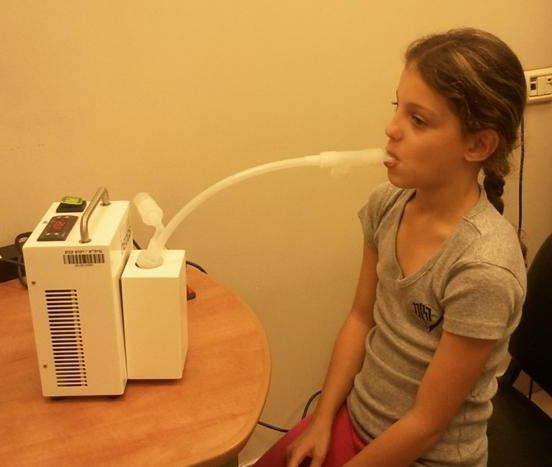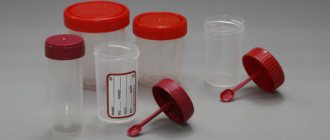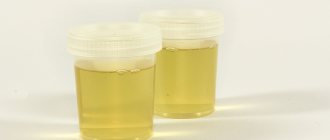If a child is intolerant to dairy foods, doctors prescribe a test for lactose intolerance. This pathology usually occurs in children; only 15% of adults have a similar enzyme disorder. Poor absorption of nutrients from milk becomes a serious problem for a child, especially for infants. After all, an adult can refuse to eat products with lactose. For an infant, mother's milk and formula are the main food. And product intolerance always negatively affects the baby’s height, weight and development.
What is lactose intolerance?
Milk and dairy products contain a sugary substance from the carbohydrate group. It's called lactose. Another name for this carbohydrate is milk sugar. A special enzyme, lactase, is responsible for its processing in the body. This substance breaks down lactose into its component parts.
If a person has a deficiency of the lactase enzyme, then this pathology is called lactose deficiency. In this case, milk sugar enters the intestines undigested, which leads to diarrhea. Nutrients from foods containing lactose are not absorbed.
From a medical point of view, it would be more correct to speak not of “lactose”, but of “lactase” deficiency. After all, it is enzyme deficiency that causes disorders. However, the term “lactose deficiency” has taken root in everyday speech. This concept means lactase deficiency.
Lactase deficiency. Types, reasons
Lactase deficiency (lactose intolerance) is a condition characterized by the inability of the body of a child or adult to digest milk sugar (lactose) due to insufficient production of the lactase enzyme in the intestines.
Causes of lactase deficiency in children
Physiological (normal) lactase deficiency
In most children over 6-7 years of age, adolescents and adults, lactase deficiency is a consequence of the body growing up and is considered a completely normal, physiological phenomenon.
A natural and gradual decrease in lactase production in the child’s intestines begins towards the end of the first year of life. By the age of 6, lactase levels may drop so low that the child can no longer properly digest large quantities of milk.
This is a genetically programmed process.
However, in some cases, a fairly high level of lactase production in the intestines persists even in adults. Scientists explain this fact by the fact that in ancient times, due to the development of animal husbandry, people gained access to animal milk, which became part of the diet of adults. This fact influenced the evolution of the human ability to digest milk and made some people able to produce lactase even as adults.
Congenital and acquired lactase deficiency
A much greater problem than the physiological decrease in lactase activity in adults is early lactase deficiency in newborns and children in the first months of life, for whom milk is the main food product.
Lactose intolerance in young children can be caused by the following reasons.
Congenital (primary) lactase deficiency is characterized by the complete inability of the newborn baby’s intestines to produce lactase. According to specialized literature, diseases of carbohydrate metabolism associated with changes in the activity of enzymes that break down sugars, including lactose, are extremely rare in the population. The incidence of such diseases varies from 1 in 20,000 to 1 in 200,000 children. As a rule, congenital lactase deficiency develops due to mutations in the genes responsible for the production of lactase. In this regard, in children under 2–3 years of age, any symptoms that are usually “attributed” to lactase deficiency are very likely to be symptoms of some other disease.
Transient lactase deficiency is a temporary inability to produce lactase in sufficient quantities/with a sufficient degree of activity, characteristic of premature or immature newborns and associated with the unpreparedness of their intestines for the process of digesting food. Typically, within a few months after birth, a premature baby's intestines develop the ability to produce lactase in sufficient quantities, and the baby begins to digest breast milk or formula well.
Acquired (secondary, temporary) lactase deficiency - occurs quite often and, as a rule, is a consequence of various intestinal diseases (intestinal infection, allergic processes in the intestines, celiac disease, etc.), which impair the ability of the small intestine to produce lactase and efficiently digest food .
Acquired lactase deficiency is a temporary phenomenon. After eliminating the diseases that caused lactase deficiency, the ability of the intestines to produce lactase is restored and lactase deficiency completely disappears.
"Overload" with lactose. This is a condition similar to transient lactase deficiency, which can be corrected by changing the organization of breastfeeding. The amount of lactose in breast milk is approximately the same throughout the feeding, but the amount of fat that the baby receives at the beginning and at the end of feeding is different. The fat content gradually increases from the beginning to the end of each feeding, the greater the difference, the more time has passed since the previous feeding, the greater the mother's breast capacity, the less the baby sucked during the previous feeding. Thus, at first the baby sucks out the more watery “foremilk”, bluish in color, with a low fat content; then, as the breast is sucked, fatter “hind milk”, white or slightly yellowish in color, begins to flow out. Lighter foremilk moves quickly through the gastrointestinal tract, and most of the lactose can enter the large intestine without having time to be broken down by the enzyme lactase. There, lactose causes fermentation, gas formation, and frequent sour stools. In small quantities, undigested lactose in any case enters the large intestine and this is the norm for a child on breastfeeding, but when the child systematically receives only foremilk, which quickly passes through the gastrointestinal tract (for example, due to limited feeding time, too frequent breast changes, too long breaks in feeding) and does not receive relief, signs of lactase deficiency appear.
Thus, in the overwhelming majority of cases, lactase deficiency in children of the first years of life is not an independent disease, but only a consequence of other diseases or errors in nutrition. In this regard, a diagnosis of lactase deficiency established in a child under 2-3 years of age can almost never be considered a complete explanation of his condition. In all cases when a child is diagnosed with lactase deficiency, it is necessary to establish the cause that disrupted the intestines’ ability to digest milk sugar, since only eliminating this cause will help to effectively solve the problem.
Today in Russia, the diagnosis of “lactase deficiency” is given to many infants. Naturally, if all these children really suffered from such a serious illness, accompanied by weight loss, humans would simply die out as a species. Very often, lactase deficiency is confused with an allergy to cow's milk protein (CMP). The symptoms are similar, and CMB is a very strong and common allergen.
Symptoms and signs of lactase deficiency in newborns and children of the first years of life
The problem of correctly assessing the symptoms and signs of lactase deficiency in young children is of great importance, since in most cases the diagnosis and initiation of treatment are entirely based on identifying the likely signs of impaired milk absorption in the intestines.
The main signs of lactase deficiency include:
— Developmental delay of the child (slow and insufficient increase in weight and height).
- Very frequent watery stools in a child, possibly with greens, foamy, coupled with developmental delays.
- False constipation: prolonged absence of stool, frequent unsuccessful urge to defecate - and loose stools, or alternating constipation and diarrhea.
- Severe constant gas formation, bloating a few minutes after the start of feeding or later.
IMPORTANT! Not episodic moments of anxiety (“in the morning and at night I feed calmly, but in the evening he begins to cry, tuck his legs, and squirm”), but a reaction to every full meal (milk or formula) containing lactose.
Other pathological processes may also occur in children with lactase deficiency. Often lactase deficiency is accompanied by anemia or allergic skin rashes. This is due to the fact that lactase deficiency can provoke a deterioration in food absorption, increased permeability of the intestinal wall, etc.
Symptoms that are NOT in themselves signs of lactase deficiency
- Colic and bloating can occur in many healthy children and are considered completely normal until the age of 6 months. Consequently, just because a child has colic in the first months of life, one cannot say that he suffers from lactase deficiency.
- Regurgitation (rare and not very abundant) - like colic, is considered a completely normal phenomenon (up to the age of 8-10 months), which does not require any treatment. Only very frequent and profuse regurgitation should cause concern, especially if it leads to disruption of the child’s nutrition and development.
Regurgitation cannot be considered a direct symptom of lactase deficiency, since the main cause of its occurrence is a malfunction of the valve that blocks the transition from the esophagus to the stomach, and with lactase deficiency, as mentioned above, there is a disruption in the digestion of milk sugar in the small intestine.
— Frequent loose stools in children in the first months of life, provided that the child looks happy and healthy, can in no case be considered a sign of lactase deficiency.
In children of the first year of life who receive predominantly liquid food in the form of breast milk or formula, stool MUST BE:
frequent (in the first month up to 10 times a day or more), liquid, with a small amount of mucus, with white lumps of undigested milk, the greenish color of the stool should also be considered completely normal.
Such stool in an infant is not diarrhea!
The rare appearance of stool (once every few days) is considered by many parents as a clear sign of constipation and forces them to take measures to “stimulate the appearance of stool.” These actions are in most cases unjustified and can even harm the child.
Even if a baby over 6 weeks of age who is exclusively breastfed has stool once a week, this should not be considered constipation if the stool remains soft and the baby feels well and is developing normally. Such stool retention cannot be considered a sign of lactase deficiency.
— The child’s anxiety from the first minutes of feeding can in no case be a sign of lactase deficiency. With lactase deficiency, the digestion of milk in the intestines is impaired. Milk enters the intestines at least 15-30 minutes after the start of feeding, and the child’s stomach and esophagus (irritation of which may be associated with crying and anxiety during feeding) work completely normally with lactase deficiency.
Methods for eliminating the causes of temporary lactase deficiency or lactose overload
I. Proper organization of breastfeeding.
1) You cannot pump after feeding (especially if this is combined with limiting the time the baby stays at the breast), because in this case, the mother pours out the hind milk or freezes it, and the baby who is suckling at the breast receives milk with a low fat content, which can provoke the development of signs of LI.
2) Offer the baby the second breast at one feeding only after the baby has completely emptied the first and released it himself (usually this takes at least 15-20 minutes for a baby in the first months of life), otherwise the baby will receive a lot of foremilk and, without having time to suck out the hind milk, it will again transfer to the front milk from the second breast.
3) If there is a lot of milk, the baby has been suckling the breast for only a short time and the mother feels that it is still quite full, and the baby no longer wants to eat, then it is better to offer the same breast at the next feeding. The general rule in case of excess milk supply is: change breasts no more than once every 2-3 hours. Most likely, after a few days of this regimen, the amount of milk will decrease, and the baby will no longer show any signs of LI.
If the baby has high weight gain, but there are symptoms similar to LN, perhaps it is the reduction in breast alternation (every 3 hours or even less often) in order to reduce the total volume of milk that will lead to a decrease in the manifestation of symptoms.
4) Do not try to maintain certain intervals between feedings. It is better to feed more often, since the longer the break, the stronger the separation of the milk.
5) It is also necessary to monitor the correct attachment of the baby to the breast (a breastfeeding consultant will best tell you about this during an in-person consultation), and also make sure that the baby not only sucks, but also swallows. In what cases can you suspect improper attachment? If you have cracks, abrasions on your nipples, and/or feeding causes pain, or you hear smacking, clicking and similar extraneous sounds during sucking. Also, feeding through shields often leads to improper latch and ineffective sucking.
6) Night feedings are very desirable: in a sleepy state, the baby is relaxed, not distracted, sucks the breast longer and more “quality”, and therefore empties it better.
7) It is undesirable to wean your baby from the breast before he is full; let him suckle for as long as he wants (especially in the first 3-4 months).
If all this does not help, perhaps we are really talking about lactase deficiency, and not about a similar condition that can be corrected with the help of proper feeding management, or about other problems with similar symptoms.
What else can you do?
II. Elimination of allergens from the diet. Most often we are talking about cow's milk protein. If CMB is an allergen for a child (and this happens quite often), allergic inflammation may occur in the intestines, which, in turn, can lead to insufficient breakdown of lactose and lactase deficiency. The solution is to exclude whole milk from the mother’s diet. You may also need to exclude all dairy products, including butter, cottage cheese, cheese, fermented milk products, as well as beef and anything cooked with butter (including baked goods). Another protein (not necessarily cow's milk) may also be an allergen.
The most common allergy-causing products include: cow's milk, chicken eggs and meat, soy, wheat, seafood, and nuts. When it is possible to identify and eliminate allergens, the child’s intestinal activity improves and the symptoms of LI stop. The effect of a restrictive diet should be expected no earlier than after 2-3 weeks. If you are allergic to cow's milk protein, the effect of eliminating the product may occur only after 3 weeks.
III. Pumping before feeding. If changing breasts less often and eliminating allergens is not enough, you can try expressing some portion of foremilk BEFORE feeding. This milk is not given to the baby, and the baby is put to the breast when fattier milk comes out. However, this method must be used with caution so as not to trigger hyperlactation. When using this method, it is optimal to enlist the support of a breastfeeding consultant.
If all this does not help, and signs of lactase deficiency persist, you should consult a doctor!
Melnikova R., breastfeeding consultant
Edited by Wolfson S., pediatrician
Sources
1. M., W. Sears. "Breast-feeding"
2. Website about lactase deficiency https://lactase.ru/
3. Scientifically based explanation of medical problems and issues https://www.sitemedical.ru/content/%D0%9F%D0%BE%D0%B4%D1%80%D0%BE%D0%B1%D0%BD% D0%BE%D0%B5-%D0%BE%D0%B1%D1%8A%D1%8F%D1%81%D0%BD%D0%B5%D0%BD%D0%B8%D0%B5-% D0%BB%D0%B0%D0%BA%D1%82%D0%B0%D0%B7%D0%BD%D0%BE%D0%B9-%D0%BD%D0%B5%D0%B4%D0 %BE%D1%81%D1%82%D0%B0%D1%82%D0%BE%D1%87%D0%BD%D0%BE%D1%81%D1%82%D0%B8-%D1% 83-%D0%B4%D0%B5%D1%82%D0%B5%D0%B9-%D0%B8-%D0%B2%D0%B7%D1%80%D0%BE%D1%81%D0 %BB%D1%8B%D1%85-%D0%BF%D1%80%D0%B8%D1%87%D0%B8%D0%BD%D1%8B-%D0%B2%D0%BE%D0 %B7%D0%BD%D0%B8%D0%BA%D0%BD%D0%BE%D0%B2%D0%B5%D0%BD%D0%B8%D1%8F-%D1%81%D0% B8%D0%BC%D0%BF
4. M. Sorokina, consultant on breastfeeding, member of AKEV. “Lactase deficiency” https://www.akev.ru/content/view/475/31/
5. N. Gerbeda-Wilson, Leader of the La Leche League. “Lactase deficiency? Don’t treat the tests!” https://www.llli.org/Russian/lactoseintolerance.html
6. L. Kazakova, pediatrician, consultant on breastfeeding “Favorite diseases of a healthy newborn” https://akev.ru/content/view/47/52/
7. D. Newman “Colic in infants” https://breastfeeding.narod.ru/newman/colic.html
8. Technique for proper breastfeeding https://breastfeeding.narod.ru/latch.html
The article was published here: https://mama-profy.ru/laktaznaya-nedostatochnost-vidy-i-prichiny
%MCEPASTEBIN%
Symptoms of deficiency
A test for lactose deficiency is prescribed to an infant with the following symptoms:
- The baby is not gaining weight well and is lagging behind in development.
- Frequent regurgitation and colic, increased gas formation.
- I'm worried about loose green stool mixed with foam.
- Sometimes stool becomes hard and difficult to pass.
- Persistent iron deficiency occurs in the body.
- On the skin you can notice inflammation like dermatitis.
The causes of lactase deficiency may vary. A genetic pathology occurs very rarely when the enzyme defect is congenital. This is the most difficult case. Sometimes such a disorder is observed in premature babies. Their enzymatic system did not have time to fully form during the prenatal period. Often lactose deficiency is a consequence of an allergic reaction to milk or intestinal diseases. In adults, this disorder usually occurs due to age-related changes in enzyme function.

Sometimes diarrhea after feeding milk occurs when the amount and activity of lactase are normal. This indicates that the baby is being overfed and is experiencing symptoms similar to lactose intolerance. What tests need to be taken to distinguish true lactase deficiency from overeating dairy foods? The following studies are usually prescribed:
- stool analysis for carbohydrates;
- coprogram with determination of acidity;
- blood test for lactose curve;
- genetic marker test;
- hydrogen test;
- intestinal biopsy (in very rare cases).
My child was replaced, or our overcoming lactase deficiency
Girls, I hasten to share my joy with you! We are finally getting better! I can't believe it! What happiness it is - a calm child and a sleeping child! He started sleeping at night! He started sleeping during the day!!! And not just once, but two or three times, or even more often) Moreover, as I wrote earlier, we did not sleep at all, day or night, but groaned, strained and screamed non-stop. As soon as I rocked him in my arms and quietly put him in bed, he immediately woke up, and everything started all over again! It was a madhouse.
What a blessing it is to be able to not carry a child in your arms for 24 hours! Go to the shower when he is sleeping, without fear that he will scream in 5 minutes. Prepare dinner. Get out! Get yourself in order! In general, I am euphoric because my hands are free!
So, let's get to the point. About 20 days ago we took a stool test for carbohydrates and dysbiosis. Severe lactase deficiency and dysbacteriosis were revealed. We visited Dr. Kopanev at the Gabrichevsky Institute, he prescribed treatment (I wrote about it in detail in one of my posts), and completely freed me from any diet. If additional feeding was necessary, he ordered additional feeding with a lactose mixture. Details here.
For a week we were treated according to the prescribed regimen, the basis of which was the well-known Lactase Baby, but there was not the slightest improvement. I do not exclude the possibility that there was no positive effect due to the fact that I dissolved the capsule in water and not milk. Firstly, the instructions themselves say that you can use either milk or water, secondly, Kopanev allowed it to be diluted with water (he said it didn’t matter), thirdly, given our schedule and lifestyle, I had absolutely no time express before each feeding and dilute with milk. Either this is the reason, or Lactase Baby simply did not help us (this happens).
Having finally despaired, I made an appointment with another doctor, whom I wanted to see initially, N.A. Antonova. Often, doctors prescribe the opposite treatment, despite working in the same institution. I was interested in the opinion of another doctor.
The first impression was positive. We were weighed, weight - 4600 (as of December 20, when we were 1 month and 12 days old). This is a very small increase (let me remind you that we were born on 4135 and discharged on 3900). Then she looked at the test results and this is what she prescribed.
To the baby:
1. Lactase Enzyme
(6 times a day, except at night).
Dissolve the capsule in 15-20 ml of milk
,
leave to stand for 10-15 minutes
. Give before or during feeding. Duration of treatment is 1.5-2 months.
First she suggested Lactase Baby. I said that she is not helping us. She replied that it was necessary to stir it in milk, but not in water (why then do the instructions mislead people?). I say, what can you say about Lactazar? I read that Lactase Baby does not help everyone, and as a second option, they take the drug Lactazar. She replied that Lactase Baby and Lactazar are analogues and there is practically no difference between them. I also read about the drug Lactase Enzyme. I say, what about Lactase Enzyme? She said that this is a stronger drug, more intended for adults, but it is also given to children (the instructions also say about children). At first she suggested continuing with Lactase Baby, and if that didn’t help, switching to Lactase Enzyme, but I wanted to start with Enzyme right away. I agreed.
The only question about this drug: the instructions say that children should be given 1/6 of a capsule dissolved in milk. I didn’t know this at the time of visiting the doctor. She prescribed 1 capsule, I gave 1 capsule. And 1 capsule per feeding helps us. Last night I gave 1/2 capsule - my stomach was very bothered: I didn’t scream, but I strained and groaned for several hours. Now I don’t know whether it’s harmful to give 1 capsule (a dose designed for an adult) 6 times (or even more, I also give it at night, otherwise I’m afraid of colic).
As for dissolving the capsule in milk, yes, I had to bother with pumping ((I can’t stand this activity, I express with a breast pump, but I don’t have enough milk, I sit for 40 minutes to barely get 50 ml. I pump 2 feedings ahead (50 ml each) I'm already used to it a little.
2. Mezim-Forte
(1/4 tablet, crush and dissolve in a teaspoon of water/milk, give 3 times a day during feeding).
Duration of treatment: 21 days.
3. Bifidumbacterin (in bottles).
1 bottle 2 times a day (15 minutes before feeding).
Duration of treatment: 10 days.
There are 10 bottles in one package; you need two packages per course.
The contents of the bottle must be dissolved in 5 teaspoons of water. I open the bottle, pour in 1 teaspoon of water (3 ml) with a syringe, shake the contents, pour it into a cup, add another 4 teaspoons of water, stir and give.
4. Lactobacterin (in bottles).
1 bottle 2 times a day (15 minutes before feeding).
Duration of administration - the next 10 days, after finishing taking Bifidumbacterin.
There are 10 bottles in one package; you need two packages per course.
5. Baby Calm
10 drops before feeding.
She praised this remedy and said that it helps well with existing colic. But, I must admit, I stopped using it (previously I only used it, but I didn’t really notice any results).
6. Bobotik 10 drops or Subsimplex 15 drops or Espumisan L 25 drops - at the time of colic (if colic has already occurred).
I give Bobotik, although I have all three drugs, but it seems to me that none of them helps us. I read that some of them help many people. After taking Bobotik, nothing changes, he still grunts, strains the same and cannot fart.
Summary: remedies 1-4 helped us a lot. Or rather, they haven’t started taking No. 4 yet, which means 1-3. This is an ideal treatment for us; all the symptoms disappeared.
In addition to medications:
1. Be sure to give your child water to drink
, in between feedings, about 100 ml of water per day. She explained that milk is a liquid food and does not replace water. Water is necessary for the proper functioning of the gastrointestinal tract. Anti-drinkers, please don't write. I don’t force water into the child, I just offer it from a bottle. He almost always drinks, sometimes a lot (after swimming, for example), sometimes a little, and rarely refuses. This does not affect feeding in any way: if he is hungry, then he only needs milk, no matter how much water he drank before. But if a child is thirsty, offering milk, compote, jelly, juice (for example, everything) instead of water is wrong.
2. Due to the small weight gain, she ordered me to get a scale and weigh the child
. If your weight gain is less than 150 g per week, supplement your diet. Of course, I'm not going to do this. True, I have acquired a scale, but I will watch it not for 1 week, but for 2-3. If there’s a really negligible weight gain, then I’ll think about it. In case of supplementary feeding, a lactose-free mixture is needed (for example, Nutrilon).
To me:
1. Hilak Forte
40 drops 3 times a day with meals.
Duration 1 month.
2. Water Donut Magnesium
1 glass 3 times a day 15-20 minutes before meals (release gas bubbles from the bottle several hours beforehand).
Duration - 4-6 weeks.
3. Senade
(if you have constipation)
1 tablet 2 times a day (as needed).
Regarding diet:
1. Dairy products are allowed (except milk): kefir, cottage cheese (up to 5% fat content), yogurt, cheese (up to 30% fat content).
2. Products containing refined sugar are not allowed. Instead - fructose and fructose-based products (in moderation). Honey is okay.
3. Fresh baked goods are not allowed.
4. Use only seasonal vegetables and fruits. I buy zucchini very often (and now too), but she said that they are full of nitrates, since it’s not the season now. Stopped. But in general, autumn-winter food infuriates me, there’s really nothing to eat at all ((All summer I ate kilograms of fruits and vegetable salads, tomatoes and cucumbers are my everything! It’s so good that by summer the child will grow up and I’ll start eating all this again))
I forgot to ask about apples... I don’t eat them just in case. I started eating cottage cheese with honey, yesterday and today, but today the child is a little restless, I blame the cottage cheese (but I’m not sure). Maybe the milk should still be removed. Valio has a very tasty low-fat and lactose-free Polar cheese, I’ll leave it alone.
We have been taking medications for five days now, and progress is obvious. I won’t say that there is no colic for a second and he hasn’t groaned once in 5 days. It happens sometimes. But this is very short-lived, and this is not a hysterical cry. Perhaps it was due to something I ate. I remember before the treatment I once ate lentil soup in the evening, something happened at night! He screamed all night (Beans are banned, of course.
And a few more rules for our successful sleep:
1. I rock him a little in my arms (or rather, I just carry him in my arms). The habit is not very good, since he is already too heavy for me (at 4600-4700), but he is unlikely to fall asleep on his own in the crib. Or he falls asleep on the chest after feeding. In my arms I hold him with his tummy down.
2. In the same position, I transfer him to bed. Exactly on the stomach. He really likes to sleep on his stomach, it turns out! And the tummy gets warm, and it’s more comfortable, or something... I used to be afraid to put him on his stomach, but now he’s not, he knows how to turn his head, if anything happens.
3. His crib is covered with a chic, warm blanket from Next, it looks like fleece, but it’s so soft and airy that as soon as his cheek touches this blanket, he easily falls asleep.
I’m not sure how useful it is to have a soft blanket under him instead of a hard surface (albeit on top of a coconut mattress), but when instead of a blanket there was a sheet/diaper, they were cold, hard, he felt very uncomfortable in his crib, I even regretted that We didn’t buy a cradle, it would have been more comfortable. For three or four nights I even put him in a stroller, he fell asleep easier there, but a stroller is not a thing, and there is no mattress there, and it is no longer possible to walk or drive in the room. I am very glad that I began to fall asleep just as well in the crib.
In general, this blanket is my best purchase) I put it under Tatamiya, and under the stroller, and I can cover it on top. Very soft and warm.

I wish all the kids health! Girls, if you decide to follow the treatment outlined in this post, perhaps there will be no harm, and maybe there will be some benefit, but if I were you, I would definitely take all the tests first (carbohydrates + dysbacteriosis) and go to the doctor (if in Moscow - I highly recommend Antonova).
Stool analysis for carbohydrates
A stool test for lactose intolerance is the simplest and most accessible. But this cannot be said to be the most informative study. This type of diagnosis is used for infants in combination with other methods.
There is no need to prepare specially for the analysis. A nursing mother should not change her diet before examining her baby. The child should eat as usual, this is the only way to get reliable results. You need to take about 1 teaspoon of the baby's stool and take it for analysis. Do not pick up feces from diapers or nappies. It is recommended to deliver the material to the laboratory within 4 hours. This will ensure the most accurate analysis results. It is allowed to store biomaterial in the refrigerator for no more than 10 hours.
The study shows the amount of carbohydrates in the stool, but does not determine the type of sugary substances. But since the baby feeds only on milk, it is assumed that lactose or its breakdown products are excreted in the feces. However, it is impossible to understand which carbohydrate norm is exceeded. In addition to lactose, galactose or glucose may be excreted in the feces during milk feeding.

The breakdown of the analysis for lactose deficiency is as follows:
- The carbohydrate rate is from 0.25% to 0.5%.
- For infants up to 1 month, reference values from 0.25% to 1% are allowed.
Diagnosis of lactase deficiency
Determination of stool pH in a caprogram
Normally pH>5.5, with lactase deficiency pH<5.5.
Diet diagnostics
If you add lactase enzyme to expressed breast milk or transfer the baby to a lactose-free formula, the stool will normalize within 5 days.
Stool analysis for carbohydrates
The feces are collected together with the liquid part - this is not allowed from a diaper. Feces for analysis can be stored in the freezer for a long time.
Important!!! In infancy (up to 1 month), the carbohydrate content in feces should not exceed 0.25 g%, and in children older than one year they are normally absent. The normal content in feces
Content of hydrogen, methane or labeled carbon dioxide in exhaled air
The concentration of gases must be determined after a load of regular or labeled lactose. Loading dose of lactose: 1 g/kg body weight, but not more than 50 g. The diagnostic criterion is an increase in hydrogen in the exhaled air after a lactose load by 20 ppm (parts per million). The method is widely used to diagnose lactase deficiency in adults and older children.
In children under 3 months without signs of lactase deficiency, the hydrogen content in exhaled air corresponds to that in adults with lactase deficiency.
Glycemic load test with lactose
Important!!! It is recommended to perform a glucose tolerance test first (see here). With impaired glucose tolerance, the glycemic curve changes during a lactose loading test.
Loading dose of lactose: 1 g/kg body weight, but not more than 50 g. The level of glucose in the blood, before and after loading with lactose, reflects the total result of the breakdown and absorption of lactose in the small intestine.
Important!!! Lactose loading can provoke the development or intensify existing disorders.
Normally, within 60 minutes after taking lactose, the blood glucose level should increase by at least 20% of the original level (approximately 1 mmol/l). Typically, blood glucose levels are determined on an empty stomach and 15, 30 and 60 minutes after exercise.
Determination of lactase activity in biopsy samples of the small intestinal mucosa
This method is the “gold standard” for diagnosing lactase deficiency. However, the complexity and high cost of the method limit its use in everyday practice.
The results are influenced by the location of the biopsy sample (from the duodenum or jejunum). In secondary lactase deficiency, the decrease in enzyme activity has varying degrees of severity on the surface of the mucous membrane, as a result of which several samples must be taken.
Important!!! Endoscopic and morphological examination of the mucous membrane of the small intestine does not provide information regarding lactase deficiency, since it does not have specific endoscopic and morphological signs.
Coprogram
A more informative method is coprogram. It is necessary to pay attention to indicators such as acidity (pH) and the amount of fatty acids. This is a simple and safe test for lactose intolerance in infants. The collection rules are the same as for testing for carbohydrates, but the material must be taken to the laboratory immediately. Otherwise, due to the work of microbes, the acidity will change.
This test for lactose deficiency is based on the fact that when there is a deficiency of the enzyme lactase, the intestinal environment becomes more acidic. This is due to the fact that unsplit lactase begins to ferment, and acids are released.
The normal pH value of stool is 5.5. A downward deviation from this indicator indicates the presence of lactose deficiency. In this case, the amount of fatty acids must also be taken into account. The more there are, the higher the likelihood of disease.

If a baby has signs of lactose deficiency, which test is better to take - a test for carbohydrates or a coprogram? This question often interests parents. We can say that the acidity level is more informative. But it is useful to take both types of stool tests, then one examination will complement the other.
Symptoms of the disease
How does lactase deficiency manifest itself? Firstly, an infant does not gain weight well. In the first year of life, the normal weight gain for a newborn is 1-1.5 kg per month. Secondly, parents notice pale skin and lethargy in the baby. The stool changes: the appearance of foam, sour odor or mucus also indicates the need to take a test for carbohydrates in the baby. The frequency of bowel movements usually reaches 8-10 times a day. But if lactase deficiency occurs, the newborn suffers from constipation. In addition, an allergic reaction can also be a manifestation of the disease. Often the mother thinks that she ate something harmful to the baby, and does not suspect that the baby needs to have her feces tested. It is worth considering that increased carbohydrates in a baby born prematurely is the norm. In this case, the mother needs to continue to feed the baby milk and repeat the test several times. It is possible that the preliminary diagnosis will be revised.
Blood test for lactose curve
The child is given a little milk to drink on an empty stomach. Then blood is taken for analysis three times within an hour. This helps track the process of lactose processing in the body.
Based on the results, a special lactose curve is constructed. It is compared with the average results of the glucose graph. If the lactose curve is located below the glycemic curve, this may indicate a deficiency of the lactase enzyme.
This test for lactose intolerance is not always well tolerated by infants. After all, if a child actually has such a disorder, then after drinking milk on an empty stomach, abdominal pain and diarrhea may occur. However, this examination is more informative than analyzing stool for carbohydrates.
The so-called "lactase deficiency"
No, and there can be no doubt that the best food for a breastfeeding baby is mother's milk. The artificial mixture cannot even come close to comparing with it in terms of nutritional properties. It is absorbed in the child’s body better than any substitutes. However, there is a widespread misconception that for any gastrointestinal disorder in a child, the cause must be sought in the inferiority of mother's milk, the presence of pathogenic microbes in the milk, or in some kind of disease.
The mother usually complains to the doctor that the baby has foamy, watery and frequent stools with a sour smell, with mucus, greens and undigested lumps, and that this causes irritation around the anus. She says that the baby is anxious during feeding, and his stomach sometimes hurts so much that he refuses to breastfeed.
Despite the fact that the child is gaining weight well, the mother believes that her milk is bad. A doctor who is not familiar with the physiology of breastfeeding only confirms her doubts: “You probably have lactase deficiency, or maybe dysbacteriosis. We need to check your milk for sterility.” And endless expensive and unnecessary tests begin (stool for dysbacteriosis, carbohydrates, coprogram, milk culture, etc.). Staphylococcus is found in mother's milk. They begin to treat the child, replacing mother's milk with a surrogate - a lactose-free formula. Everything seems to stop. And everyone breathes a sigh of relief. The myth that mother's milk can be bad is strengthened in the mind. But this is even impossible in principle!
Let's figure out what's really going on. Nine months of intrauterine life are not enough for a newborn child’s organs and systems to fully mature. Mother's milk gives him this opportunity. The composition of milk changes as the baby grows. In the first 3-4 days of life, the child receives colostrum, then transitional milk.
Colostrum, despite its small amount, is more suitable in composition to the needs of a newborn baby, so it is easily absorbed by the body. Compared to mature breast milk, it contains more proteins. Colostrum also contains less lactose, fat, and water-soluble vitamins than mature breast milk. However, it contains more fat-soluble vitamins and some minerals, hormones, immune and other protective factors.
Colostrum provides local protection to the mucous membrane of the gastrointestinal tract of infants. This allows us to consider it not only as food, but also as a biologically active product necessary for the normal development of a newborn in the first days of life. This is why it is so important to put your newborn to the breast within 20-30 minutes after birth. And how often this important moment is missed in the maternity hospital!
Only from the 2nd to 3rd week after birth, a woman’s breast milk becomes mature and acquires a relatively constant composition. At this time, the main gastrointestinal disorders in the baby appear.
Now everyone knows that mature milk is heterogeneous. The “front” portion of milk is more watery (so the baby does not need additional water). This portion contains a lot of lactose (the main carbohydrate in human milk), vitamins, minerals, and immunoglobulins that protect the baby. Well, the “back” portion contains more fats and enzymes that digest milk.
Lactose is absorbed in the small intestine under the influence of the lactase enzyme. An infant under 3 months of age has a physiological deficiency of this enzyme (or its low activity), and therefore part of the undigested lactose enters the large intestine. But this is necessary, because there, under the influence of bacteria, lactose is converted into lactate and short-chain fatty acids, and they are a source of energy for nerve cells and the large intestine. In addition, the acidity of the intestinal contents increases, creating an unfavorable environment for pathogenic microbes and promoting the growth of lactobacilli, which are beneficial for digestion. The absorption of calcium, iron, zinc and phosphorus also improves. Gases are a by-product of fermentation.
The abundance of gases in infants is normal and is determined by the intensity of fermentation processes.
In some children, the lactase enzyme matures later than usual, but true lactase deficiency, which is genetically determined and associated with the complete absence or severe deficiency of this enzyme, is extremely rare.
Why do pediatricians find lactase deficiency in almost every second child? How could humanity survive if this disease, which leads to debilitation and death (if left untreated), occurs, in their opinion, in half of babies?
And the whole point is that the described painful phenomena are a consequence of erroneous recommendations for feeding. The child is not fed correctly; he receives a lot of lactose-rich “forward” milk, but does not receive “hind” milk, which is fattier.
Ignorance of the physiology of breastfeeding is not the fault of pediatricians, but rather their misfortune. Indeed, in the last 25 years, doctors have dealt mainly with children fed with artificial formula. Manufacturing companies have done everything possible to make our women forget how to breastfeed (in Moscow, only 12% of women breastfeed for up to a year, whereas at the beginning of the last century almost 100% of babies were breastfed). Accordingly, much of the knowledge of doctors and laboratory tests are applicable only to “artificial” people.
Scientists of the Institute named after. Gabrichevsky suggest revising the norms for carbohydrate content in the feces of a breastfed child (up to 1 month - 1%; 1-2 months - 0.8%; 2-4 months - 0.6%; 4-6 months. -0.45%, over 6 months - accepted and currently 0.25%.).
And I’ll say it again: the presence of sugar in a breastfed baby’s stool is normal! But high sugar in the stool of a bottle-fed baby is a pathology! If your child has green, foamy stool with undigested lumps, abdominal pain, bloating, and is not gaining weight well, pay attention, first of all, to how you feed him. Take your time to examine his feces and your milk, and even more so, transfer your baby to artificial formula.
Breastfeeding is a very simple process, if not elementary. But! Only if you follow a few simple rules, without knowledge of which it cannot take place:
* The baby must be latched correctly, otherwise there will not be enough breast stimulation to produce the required amount of milk. Even with frequent feedings, it is difficult for a child with improper attachment to extract “hind”, fatty milk from the breast;
* Until lactase (3-4 months), it is necessary to feed the baby at least 10-12 times, allow him to be at the breast as much as he wants;
* It is necessary to ensure that the child not only sucks the breast, but also swallows the milk;
* Do not express, as this stimulates the production of predominantly “foremilk”;
* It is necessary to feed the baby at night, then the nutrition will be more balanced - after all, it is at night that more “hind” milk is produced.
If you follow these rules, then you most likely will not need to examine and treat the child, use lactase , and even more so, transfer him to artificial feeding. There will also be no need to limit your diet, with the exception of milk and sweets. Biological products are not required either.
According to Professor Hernell O. from Sweden, in their country the feces of breast-fed children are not examined for carbohydrates.
Always read the annotations. Plantex and bifidumbacterin , which are often prescribed, contain lactose. Therefore, think carefully before using them. Abomin will not help here at all, but will only harm. But if, despite properly organized breastfeeding, your child continues to suffer from pain and lose weight, be sure to contact a pediatrician who is in favor of breastfeeding .
Goncharova Vera Alexandrovna,
neonatologist, lactation consultant,
Hydrogen test
The amount of hydrogen in the air exhaled by the child is determined. With lactose deficiency, fermentation processes occur in the intestines. As a result, hydrogen is formed, which penetrates the blood and then exits through the respiratory system.
The child exhales into the measuring device. The concentration of hydrogen and other gases in the air leaving the lungs is recorded. This is the basic indicator. The patient is then given milk or a lactose solution. After this, repeated measurements of hydrogen are made and the results are compared.
Normally, the deviation from the baseline after the lactose test should not be more than 0.002%. Exceeding this number may indicate lactose intolerance.

This test is rarely performed on infants; it is usually used on older children and adults. The disadvantage of the test is the possible deterioration of well-being if the child actually suffers from lactose deficiency.
Genetic test
Genetic testing for lactose deficiency helps identify this disorder if it is congenital. This is a study for a special marker C13910T.
Blood is taken from a vein for analysis. The study is carried out on an empty stomach or 3 hours after eating. There are three possible analysis results:
- C/C - this means that the child has genetic lactose intolerance.
- S/T - this result indicates the patient’s tendency to develop secondary lactase deficiency.
- L/T means the person has normal lactose tolerance.

Intestinal biopsy
This is a very reliable, but traumatic research method. It is extremely rarely used in infants. Under general anesthesia, a probe is inserted through the child's mouth into the small intestine. Under endoscopic control, pieces of the mucous membrane are pinched off and taken for histological examination.
In itself, minor trauma to the mucous membrane is not dangerous, since the epithelium is quickly restored. But anesthesia and the introduction of an endoscope can lead to complications. Therefore, when examining young children, this method is used only in the most extreme cases.
Lactose deficiency in adults
In adults, lactose intolerance is either congenital or caused by gastrointestinal diseases and age-related changes. The disease manifests itself in gastrointestinal disorders after consuming dairy products. As a result, the person avoids eating foods containing lactose. Because of this, his body does not receive enough calcium, which negatively affects the condition of his bones.
In addition to the diagnostic methods listed above, there is another test for lactose intolerance in adults. The patient is given 500 ml of milk to drink, and then a blood sugar test is taken. If the glucose level becomes less than 9 mg/dl, this indicates a malabsorption of lactose.

What to do if there is a deviation from the norm in the tests?
The only incurable pathology is genetically determined lactose intolerance. In this case, lifelong diet and lactase replacement therapy are necessary. If lactose deficiency occurs due to the child’s prematurity, then after some time the enzyme system begins to develop, and the body is filled with lactase.
In all cases, it is necessary to prescribe a diet with limited dairy products. In some situations, lactose-free and low-lactose formulas, as well as soy milk products, are used to feed infants.
The following drugs are used to treat lactase deficiency:
- lactase enzyme substitutes;
- prebiotics;
- medicines for diarrhea and flatulence;
- antispasmodics for abdominal pain.
Adults are advised to use calcium supplements, as due to the forced refusal of dairy products they have an increased risk of developing osteoporosis. In most cases, lactose intolerance has a favorable prognosis.










